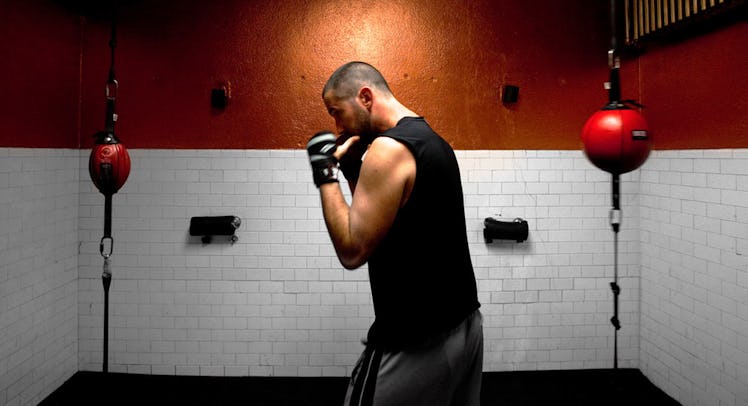The Importance Of The Microbiome For Men
It'll help you become a healthier, happier dude.

You are not alone. And not just because you constantly have a kid lurking about, ready to spook you at all minutes of the day. The “you” you know may comprise of as little as 10 percent of what you consider your body. That’s because for every human cell you possess there are 10 resident microbes—fungi, bacteria, viruses—living on and in you. That’s trillions of travelers creating an invisible shield that helps you function on a day-to-day, minute-by-minute, cell-by-cell basis.
Don’t douse yourself in disinfectant just yet. While scientists are just beginning to learn more about this collection of symbionts known as the microbiome — they’re there to help. Dr. Jack Gilbert, director of the Microbiome Center at the University of Chicago Medicine and co-author of the forthcoming Dirt Is Good: The Advantage Of Germs For Your Child’s Developing Immune System likens them to the “park ranger of the body” which “helps condition and control your micro-ecosystem to keep it healthy.” In fact, they help maintain your immunity and digestion, and even regulate your mood. But don’t think you can reap the bacterial benefits without putting in some work; treat your microbiome poorly and you could become a cranky, gassy, cloudy-headed dude whose immune system is as easy infiltrate as your grandma’s Wi-Fi.
Here, Gilbert, along with Dr. Orla O’Sullivan of the APC Microbiome Institute at University College Cork in Ireland explain how to keep the trillions of invisible friends with benefits happy.
Diversity Is Key
A multi-cultural microbiome is a healthy microbiome. “It’s like a box of crayons,” says O’Sullivan. “If you only have red crayons, you could only do a red picture. You need every single color to do a proper picture.” If there is only one bacterium in your microbiome, you’d only be protected against one pathogen. The good news is that your microbiome gets more diverse as you grow — for a while, at least. O’Sullivan says you start to lose microbe diversity as you age.
But the food you eat plays a big part. Get a variety of real foods into your gut and avoid the junk. “Eat a diverse diet of unprocessed foods,” O’Sullivan says. “If you only eat one healthy food for the rest of your life, like an apple, you’d only have one bacteria to digest that food and nothing else. A diverse diet equals a diverse microbiome.” So much for chowing down on a pizza roll a day.
Get Sweaty
The bacteria on and in your body likes to get moving. O’Sullivan and her team are currently investigating the relationship between the microbiome and activity levels by studying those of professional rugby players. And they’ve found that there’s a “huge diversity of microbiome associated with the athletes’ fitness levels.” Whether it’s cause or effect is still unknown, but she says it’s a pretty safe bet to say that that moderate exercise leads to a healthier microbiome.
Avoid Antibiotics When You Can
Blasting away those occasional zits with a regimen of tetracycline may not be the best course of action for your health in general. “Overuse of antibiotics can push the microbiome to a state where it can no longer protect health,” says Gilbert, who recommends discussing any sort of antibiotic use with your doctor. Of course, if you’re sick, it may be necessary. Luckily, your microbiome should be able to recover. “An antibiotic will decrease your microbiome’s diversity, but if you return to healthy eating it will bounce back,” O’Sullivan says. “Of course, repeated antibiotics use would wipe it out.”
Same Goes For All That Hand Sanitizer
Yeah, you should squirt some if you’ve been touching dive bar walls or your kid’s dirty diapers. But go easy. More and more evidence points to their potential harms of antimicrobial solutions outweighing their benefits. “Antibacterial soaps affect your skin’s microbiome,” O’Sullivan says. “There’s a hypothesis about hygiene that there are more cases of asthma and more people with allergies because we’re not exposed to enough bacteria.” Yes, the key word is hypothesis. But repeatedly nuking microbiome neighborhoods won’t bode well.
No, You Don’t Have To Down Tons Of Yogurt
A lot of folks love to hype the health aspects of probiotics, the active cultures found in such dairy products as yogurt. And while these substances contain good bacteria, the effect is transient. “Most healthy people don’t need them,” O’Sullivan says. “They have diverse microbiomes already.” They could help your microbiome recover if, say, you need to take an antibiotic. “After an assault on your microbiome, take a probiotic,” O’Sullivan says. You’re still cool, though, Gogurt.
Chow Down On Some Fermented Foods
Better than taking probiotics would be to take prebiotics, a non-digestible ingredient that helps cultivate your microbiome. These are found in some foods and promote the growth of good bacteria. “When mice are fed prebiotics, they have reduced stress levels,” O’Sullivan says. Prebiotics are naturally found in bananas and onions as well as fermented food like kefir, sauerkraut, kombucha, and pickles. And while there’s no word why, O’Sullivan adds that red wine might help, too. In moderation, of course. Red wine and pickle backs for all!
This article was originally published on